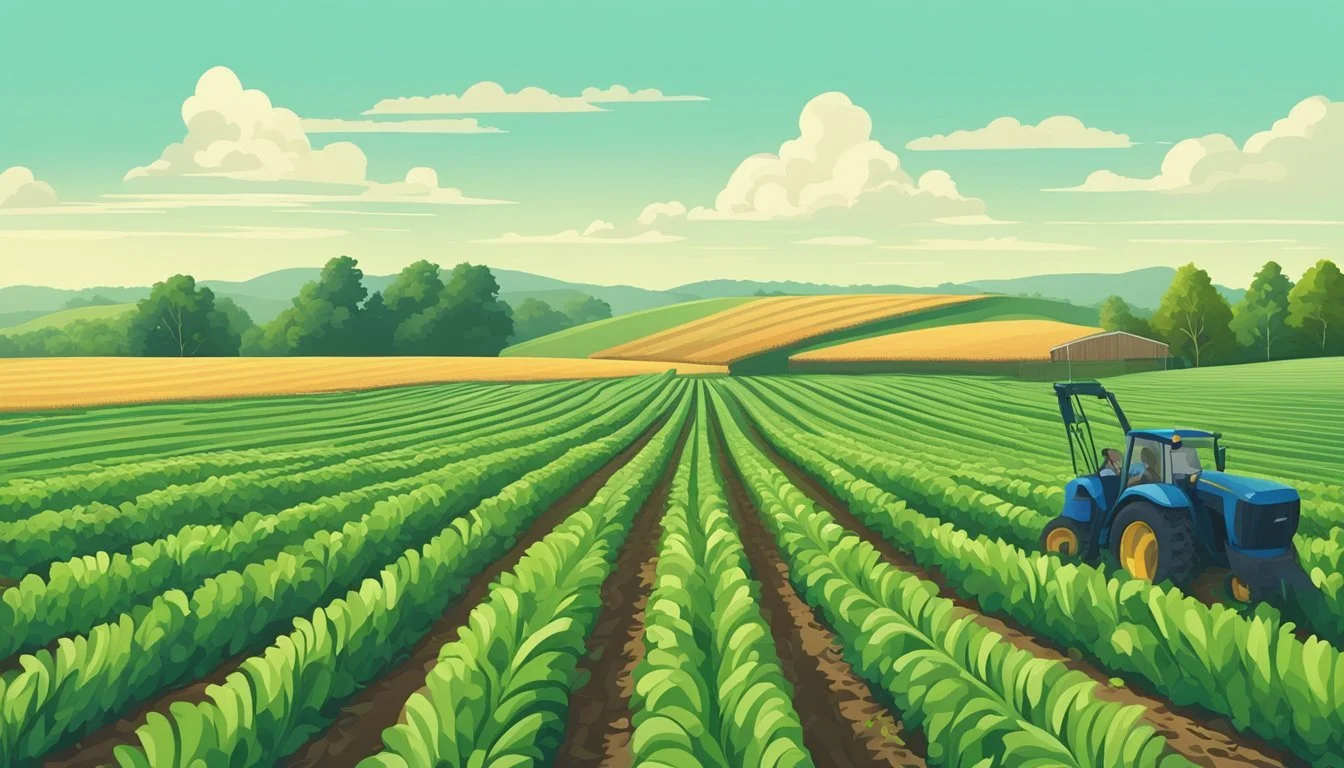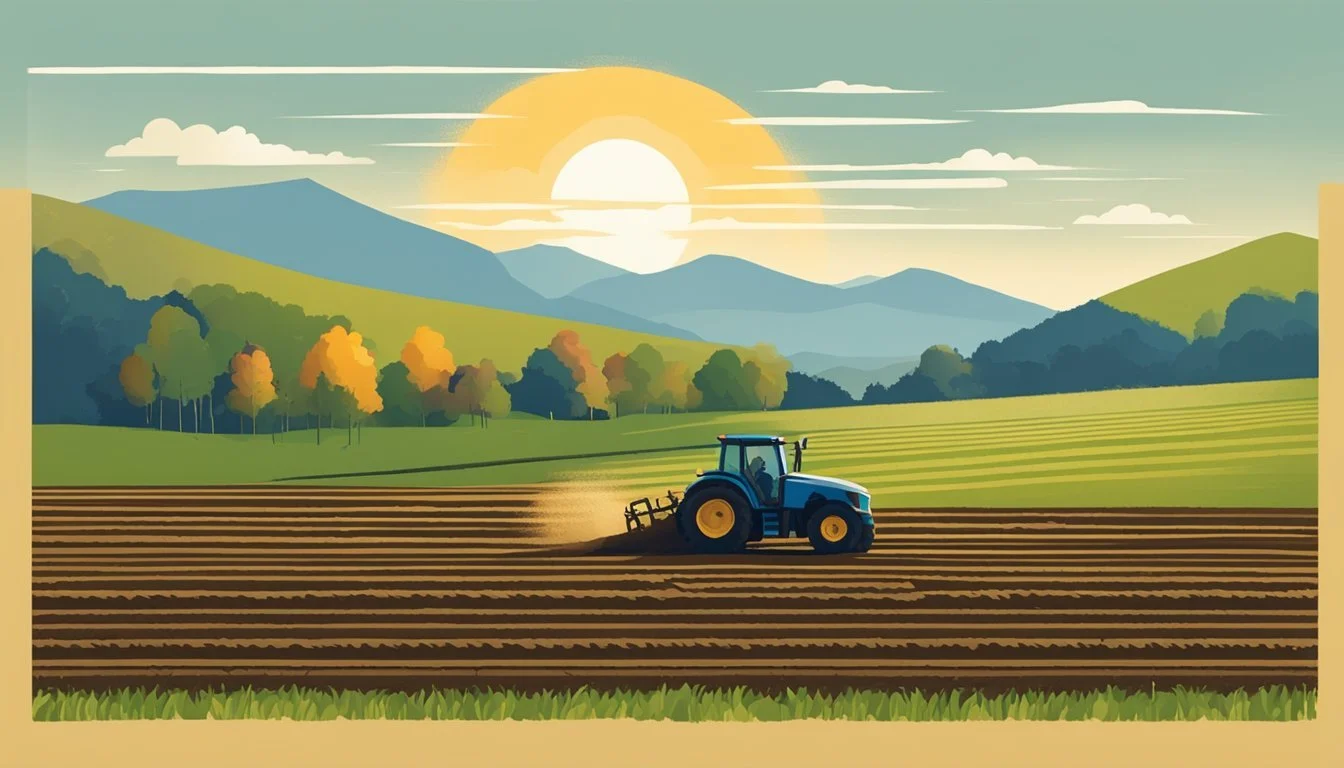Guide to Farming in Georgia
Essential Tips for Cultivating Success
This Article is Part of Our State by State Farming Guide
Farming in Georgia is characterized by its rich history and significant contribution to both the state's economy and the nation's food supply. With the Georgia Department of Agriculture being the oldest state department of its kind in the United States, Georgia has long played an important role in agricultural development and innovation. The state's farmers are known for producing a diverse array of crops and livestock, owing to the region's favorable climate and varying landscapes. From the fertile plains to the rolling hills, Georgia's agricultural zones offer a conducive environment for a variety of farming activities.
The state's agricultural plan is comprehensive, extending support to farmers, consumers, and businesses alike. Georgia's guidelines for planting and harvesting are tailored to maximize yield and ensure sustainability. For instance, the planting guide for row crops provides detailed information on seeding rates, the best planting dates, and days to maturity, which are crucial for successful crop production. Corn (how long does corn last?) farming, in particular, stands out as a vital segment of Georgia's agricultural sector, contributing significantly to the livestock and ethanol industries, and is cultivated based on precise agricultural practices to ensure high yields and quality production.
Farmers in Georgia benefit from the guidance and regulation provided by the Georgia Department of Agriculture, which covers a broad spectrum of areas including animals, food, fuel, plants, soil, and pesticides. Through adherence to certified seed quality standards and meticulous cultivation plans, Georgia maintains its position as a leader in agricultural production in the Southeastern United States. The department's efforts to aid farmers through education, market development, and regulatory support reflect a robust and dynamic approach to modern agriculture.
Understanding Georgia's Agricultural Landscape
Georgia's diverse agricultural environment is characterized by regional variations, distinct climate patterns, and a range of soil types. These elements together shape the farming practices and crop choices across the state.
Regional Farming Variations
In North Georgia, the agricultural focus is often on poultry, cattle, and specialty crops due to the hilly terrain and cooler climate. Middle Georgia supports a mix of agriculture including peaches, cotton, and peanuts. Extreme South Georgia is known for vegetable production and boasts a longer growing season, which allows for a variety of crops including citrus, blueberries, and vegetables.
Climate and Weather Conditions
Georgia's climate is typically humid subtropical, with hot summers and mild winters. This climate benefits a wide range of agricultural pursuits but also poses challenges such as disease and pest pressure. Farmers rely on weather forecasts and historical climate data to plan planting and harvesting cycles, with a heightened focus on water management during periods of drought or excessive rainfall.
Soil Types and Fertility
Soil in Georgia is as varied as its climate. North Georgia has clay and loam soils with varying degrees of acidity. Here, soil tests are crucial for determining lime and fertilizer needs. In Middle Georgia, soils range from sandy to clay loams with moderate fertility. Farmers often enhance the soil through amendments based on soil test results. Extreme South Georgia typically deals with sandy soils, which have lower soil fertility and may require regular applications of fertilizer. The pH levels of soils throughout Georgia influence nutrient availability and are a key component of soil management.
Preparation for Planting
Proper planning and soil management are essential for a successful farming venture in Georgia. Selecting the appropriate crops for the climate, preparing the soil with the right amendments, and creating a comprehensive garden plan sets the foundation for a plentiful harvest.
Selecting the Right Crops
When selecting crops, farmers should consider Georgia's USDA hardiness zones, which range from 6 to 9. This factor, along with knowledge of the first and last frost dates, influences the choice of seeds and planting dates. Common crops include:
Vegetables: Tomatoes, peppers, and leafy greens
Fruits: Peaches, apples, and berries
Soil Preparation and Amendments
Soil preparation is the base on which crop growth relies. A soil test is recommended months prior to planting to determine the need for lime and fertilizer. If the soil pH is low, indicating acidity, lime should be applied. A balanced application of nutrients through fertilizers, compost, and manure is critical:
Apply lime as suggested by soil test results.
Incorporate organic matter such as compost or manure to improve fertility.
Use mulch to conserve moisture and suppress weeds.
Creating an Effective Garden Plan
An effective garden plan includes mapping out the placement of crops and considering crop rotation. A well-thought-out plan incorporates the quantity of each vegetable, accounting for fresh consumption, as well as preserving needs through canning and freezing.
Garden Layout: Document the layout to scale, considering sunlight and water access.
Crop Rotation: Rotate crops to prevent soil nutrient depletion and reduce pest issues.
Record Keeping: Maintain records of planting dates and varieties for future reference.
Cultivation Techniques
Successful farming in Georgia involves a set of specific cultivation techniques tailored to the region's climate and soil conditions. The following methods are fundamental for achieving optimal growth and yield from crops.
Planting and Seeding
The initial step in crop production is to plant seeds at their proper depth into a well-prepared seedbed. Soil temperatures and moisture levels need to be conducive to the species being planted. Seeding rate must be precise, complying with recommendations for the particular crop to avoid issues such as thin stands or overcrowding, which can lead to problems like damping off.
Field preparation: Create a fine seedbed that is free of weeds and debris.
Depth and spacing: Follow specific guidelines for each crop to ensure adequate growth.
Timing: Plant at a time when conditions are known to be most favorable for the crop.
Watering and Irrigation
Irrigation plays a vital role in plant growth, especially during periods of insufficient rainfall. Efficient watering practices help maintain soil moisture levels without waterlogging the plants. Use of irrigation systems such as drip or furrow irrigation can conserve water and reduce the prevalence of diseases.
Schedule: Irrigate based on the crop's specific growth stages and climatic conditions.
Techniques: Choose an irrigation method suitable for the crop and soil type to ensure even distribution of water.
Weed and Pest Management
To maintain high yields, it is essential to control weeds, pests, and diseases. Weed and pest management begins with the selection of appropriate pesticides and continues through regular monitoring of the crop. Mulching materials help suppress weeds and can also improve soil moisture and temperature.
Mulching: Utilize appropriate mulching materials to discourage weed growth and retain soil moisture.
Pesticide application: Apply pesticides judiciously, considering the crop stage, pest levels, and environmental impact.
Nitrogen side-dressing: Additional nitrogen may be applied to promote healthy plant growth and increase resistance to pests and diseases.
Through thoughtful use of these techniques, farmers can ensure the health and productivity of their fields in Georgia.
Crop Specific Guidelines
In Georgia, farmers adhere to tailored strategies for each crop, ensuring optimal yield and sustainability. Soil quality, planting dates, and specific crop management techniques are pivotal components of successful agricultural production.
Vegetables and Greens
Vegetables such as tomatoes, beans, onions, pepper, carrots, and spinach demand well-drained soil and a consistent monitoring of pests and diseases for successful cultivation. Organic vegetable farming places an emphasis on natural fertilizers and soil conditioners. For example, onions benefit from a pH of 6.0 to 6.8 and require a nutrient-rich soil. Planting should follow recommended schedules; for instance, tomatoes are typically transplanted after the last frost date to prevent cold damage.
Fruits and Berries
Fruit and berry crops, including melons, cucumbers, and squash, require careful consideration of pollination needs to ensure quality production. For example, melons depend on bee pollination for fruit set. Appropriate spacing and trellising in melons and cucumbers can improve sun exposure and air circulation, reducing the risk of disease. Berries require soil with good drainage and often need a lower pH to thrive.
Grains and Field Crops
Grains and field crops like corn (specifically sweet corn), oats, peanuts, soybeans, (how long do soybeans last?) and cotton, are typically grown on a larger scale and require comprehensive management. Farmers must pay close attention to:
Planting Dates: For instance, sweet corn's ideal planting date in Georgia is from March to July.
Soil Preparation: Crops like peanuts and cotton demand distinct soil types; peanuts prefer sandy loam, while cotton thrives in well-drained, fertile soils.
Pest and Disease Control: Field crop farmers often rely on integrated pest management strategies to safeguard their yields.
Here is an example focusing on corn production specifics:
Factor Requirement for Corn Soil Type Loamy soil with adequate drainage pH Range 5.8 to 6.5 Planting Depth 1.5 to 2 inches Planting Date Mid-March to Mid-May Row Spacing 30 to 36 inches Irrigation Essential for non-drought resistant varieties Fertilization Based on soil test recommendations Harvest 65 to 90 days after planting, depending on variety
Incorporating these detailed practices for each specific crop is key to a successful harvest.
Management of Farm Resources
Effective management of farm resources in Georgia encompasses precision in nutrient handling, incorporation of organic practices, and the application of sustainable farming methodologies. These practices aim to enhance productivity while minimizing the environmental impact.
Nutrient Management
Farmers utilize nutrient management to optimize the use of fertilizers such as nitrogen, ensuring that crops receive the precise amount needed for optimal growth, while mitigating runoff into waterways. Methods include the application of manure or compost as natural fertilizers, which replenishes the soil with organic matter and reduces the dependency on synthetic inputs.
Nitrogen Usage: Careful calculation of nitrogen requirements based on soil tests and crop needs.
Organic Matter: Incorporation of manure and compost to improve soil structure and fertility.
Organic Farming Practices
Organic farming in Georgia prioritizes the use of natural inputs and processes to maintain soil fertility and plant health. Farmers avoid synthetic pesticides and fertilizers, instead using organic materials to enrich the soil.
Natural Fertilizers: Utilization of compost and animal manure to maintain nutrient levels.
Pest Management: Selection of disease-resistant crop varieties and use of biological pest control methods.
Sustainable Farming Methods
The focus on sustainable farming methods is pivotal in preserving Georgia's agricultural landscape for future generations. These practices aim to balance the need for food production with environmental stewardship.
Soil Conservation: Implementation of no-till or reduced tillage to prevent soil erosion.
Water Conservation: Installation of intelligent irrigation systems to minimize water usage and protect water quality.
Harvesting and Post-Harvest
In Georgia, successful harvesting and post-harvest management are critical for ensuring high-quality food reaches consumers and the market. These stages are pivotal in the agricultural business, influencing both profit and culture.
Harvesting Techniques
Harvesting techniques in Georgia vary by crop. For corn, which is a significant row crop, timely harvesting is crucial to maintain quality and prevent losses. Typically, the harvest occurs when the moisture content of the kernels is just right, which is determined by regular testing. Pomegranates and other fruits may require different approaches, such as hand-picking to prevent bruising.
Storage and Preservation
Once harvested, crops must be stored properly to preserve quality. Grains like corn and wheat, are often dried to a specific moisture content and then stored in silos to protect them from pests and moisture. Vegetables from a garden can be kept fresh in cool, moisture-controlled environments. Emphasis is placed on storage techniques that prevent spoilage and maintain the nutritional value of the food until it reaches the consumer or is further processed.
Marketing and Selling Your Produce
Marketing produce effectively involves understanding the local culture and preferences. Georgia farmers may sell directly through farmers' markets or to local businesses. Presentation and quality are key as they impact consumer choices. When marketing, farmers highlight the freshness and local origin of their produce, which are important selling points. Accurate market knowledge helps in pricing products competitively while maintaining a sustainable business model.
Livestock and Poultry Management
In Georgia, livestock and poultry management is integral to the agricultural sector, focusing on aspects such as breeding, care, product processing, and economic considerations. Effective management ensures the health of the animals and the financial viability of farming businesses.
Breeding and Care
Breeding and care are fundamental to livestock and poultry management. Producers must ensure that the genetic quality and health of their animals are maintained to achieve optimal production levels. In Georgia, the isolation of new or returning animals for a period of four weeks is recommended to protect against disease transmission. Daily inspections for symptoms of disease are crucial for early detection and containment. The well-being of poultry is enhanced through advanced farming technologies, leading to hens producing 250-300 eggs annually due to better nutrition and health strategies.
Product Processing
Product processing involves transforming raw livestock and poultry products into market-ready items. Farmers in Georgia are responsible for ensuring that the processing of products like eggs and meat complies with food safety regulations. For example, managing poultry disposal pits with environmental care is necessary to maintain sustainability. Utilizing efficient feed strategies, where one pound of meat is produced for approximately two pounds of feed, not only improves resource utilization but also contributes to cost-effective product processing.
Economic Considerations
The economic health of livestock and poultry businesses in Georgia hinges on careful planning and adherence to best practices. Farmers engage in various management activities including nutrient management, waste management, and crop management to ensure economic sustainability. Employment of these practices, along with informed financial decisions, is vital for maximizing profits and sustainability.
In summary, comprehensive management of livestock and poultry in Georgia includes careful attention to breeding, care, product processing, and the economic aspects of farming, all geared towards sustaining both animal health and business health.
Financial Planning and Support
In Georgia, a well-structured financial plan is essential for new and established farmers alike. Supportive programs and management tools are available to assist with funding sources and mitigating risks associated with agriculture businesses.
Budgeting and Financial Management
Budgeting is a crucial first step for farmers to turn their ideas into actionable plans. A detailed budget aids in setting financial goals and establishing a framework for the farm's operations. Effective financial management involves:
Tracking expenses and revenues: Rigorously monitor cash flows to make informed decisions.
Analyzing cost of production: Understand the cost associated with each commodity produced to set appropriate prices.
Government Programs and Grants
The USDA offers various programs to support farms through loans, grant funding, and other financial assistance. Farmers can explore options such as:
USDA Grants and Loans: Accessibility to different federal, state, and local funding.
Veterinary Education Loan Repayment Program: Financial aid for veterinarians serving in rural areas.
Insurance and Risk Management
Risk management is fundamental in farming due to the unpredictability of factors like weather and market prices. Insurance can provide a safety net, with key aspects being:
Crop insurance: Protection against crop loss or damage.
Revenue insurance: Safeguards farm income against price fluctuations.
By integrating robust financial planning with the available support resources, farmers in Georgia can ensure sustainable growth and stability for their agricultural endeavors.
Farming Laws and Regulations
In Georgia, a robust framework guides farming practices, ensuring that agriculture thrives in compliance with state regulations and standards set forth by the Georgia Department of Agriculture. Farmers must understand these policies and adhere to regulations concerning safety, and environmental protection.
Understanding Farm Policies
Georgia’s agricultural policies are established by the Georgia Department of Agriculture, the oldest state department of its kind in the U.S. Farmers should be familiar with the Right-to-Farm Law, which aims to protect farming operations by discouraging nuisance lawsuits and unnecessary regulations. However, staying informed about legislative changes is crucial as these policies evolve over time.
Key Entities: Georgia Department of Agriculture, Right-to-Farm Law
Significance: Protection of farmers, reduction of frivolous legal challenges
Compliance with Safety Standards
Farmers must comply with safety regulations overseeing the production and sale of food and other agricultural products. This involves following guidelines related to the handling of animals, food safety, and the storage of fuel. Adherence to these standards not only ensures consumer safety but also enhances the credibility and quality of Georgia's farm products.
Safety Areas:
Animal care and welfare
Food safety protocols
Fuel and chemical storage
Environmental Protection
Environmental regulations play a significant role in Georgia’s farming laws. The Georgia Department of Agriculture oversees the appropriate use of pesticides and the management of soil health, aiming to minimize agriculture’s ecological footprint. Farmers are expected to uphold these regulations to preserve Georgia's natural resources for future generations.
Regulatory Focus: Pesticide use, soil conservation, water quality
Goal: Sustainable farming practices, protection of Georgia’s arable land and forests








